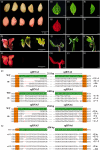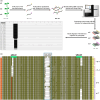High efficient multisites genome editing in allotetraploid cotton (Gossypium hirsutum) using CRISPR/Cas9 system
- PMID: 28499063
- PMCID: PMC5785356
- DOI: 10.1111/pbi.12755
High efficient multisites genome editing in allotetraploid cotton (Gossypium hirsutum) using CRISPR/Cas9 system
Abstract
Gossypium hirsutum is an allotetraploid with a complex genome. Most genes have multiple copies that belong to At and Dt subgenomes. Sequence similarity is also very high between gene homologues. To efficiently achieve site/gene-specific mutation is quite needed. Due to its high efficiency and robustness, the CRISPR (clustered regularly interspaced short palindromic repeats)/Cas9 system has exerted broad site-specific genome editing from prokaryotes to eukaryotes. In this study, we utilized a CRISPR/Cas9 system to generate two sgRNAs in a single vector to conduct multiple sites genome editing in allotetraploid cotton. An exogenously transformed gene Discosoma red fluorescent protein2(DsRed2) and an endogenous gene GhCLA1 were chosen as targets. The DsRed2-edited plants in T0 generation reverted its traits to wild type, with vanished red fluorescence the whole plants. Besides, the mutated phenotype and genotype were inherited to their T1 progenies. For the endogenous gene GhCLA1, 75% of regenerated plants exhibited albino phenotype with obvious nucleotides and DNA fragments deletion. The efficiency of gene editing at each target site is 66.7-100%. The mutation genotype was checked for both genes with Sanger sequencing. Barcode-based high-throughput sequencing, which could be highly efficient for genotyping to a population of mutants, was conducted in GhCLA1-edited T0 plants and it matched well with Sanger sequencing results. No off-target editing was detected at the potential off-target sites. These results prove that the CRISPR/Cas9 system is highly efficient and reliable for allotetraploid cotton genome editing.
Keywords: CRISPR/Cas9; allotetraploid; cotton; genome editing; high-throughput sequencing.
© 2017 The Authors. Plant Biotechnology Journal published by Society for Experimental Biology and The Association of Applied Biologists and John Wiley & Sons Ltd.
Figures






Similar articles
-
High-efficient and precise base editing of C•G to T•A in the allotetraploid cotton (Gossypium hirsutum) genome using a modified CRISPR/Cas9 system.Plant Biotechnol J. 2020 Jan;18(1):45-56. doi: 10.1111/pbi.13168. Epub 2019 Jun 7. Plant Biotechnol J. 2020. PMID: 31116473 Free PMC article.
-
Highly Efficient Genome Editing Using Geminivirus-Based CRISPR/Cas9 System in Cotton Plant.Cells. 2022 Sep 16;11(18):2902. doi: 10.3390/cells11182902. Cells. 2022. PMID: 36139477 Free PMC article.
-
Targeted mutagenesis in cotton (Gossypium hirsutum L.) using the CRISPR/Cas9 system.Sci Rep. 2017 Mar 13;7:44304. doi: 10.1038/srep44304. Sci Rep. 2017. PMID: 28287154 Free PMC article.
-
CRISPR/Cas9: an advanced tool for editing plant genomes.Transgenic Res. 2016 Oct;25(5):561-73. doi: 10.1007/s11248-016-9953-5. Epub 2016 Mar 24. Transgenic Res. 2016. PMID: 27012546 Review.
-
The CRISPR/Cas9 system and its applications in crop genome editing.Crit Rev Biotechnol. 2019 May;39(3):321-336. doi: 10.1080/07388551.2018.1554621. Epub 2019 Jan 15. Crit Rev Biotechnol. 2019. PMID: 30646772 Review.
Cited by
-
Herbicide Resistance: Another Hot Agronomic Trait for Plant Genome Editing.Plants (Basel). 2021 Mar 24;10(4):621. doi: 10.3390/plants10040621. Plants (Basel). 2021. PMID: 33805182 Free PMC article. Review.
-
Precise fine-turning of GhTFL1 by base editing tools defines ideal cotton plant architecture.Genome Biol. 2024 Feb 26;25(1):59. doi: 10.1186/s13059-024-03189-8. Genome Biol. 2024. PMID: 38409014 Free PMC article.
-
Degradation of de-esterified pctin/homogalacturonan by the polygalacturonase GhNSP is necessary for pollen exine formation and male fertility in cotton.Plant Biotechnol J. 2022 Jun;20(6):1054-1068. doi: 10.1111/pbi.13785. Epub 2022 Feb 18. Plant Biotechnol J. 2022. PMID: 35114063 Free PMC article.
-
Genome-Scale Analysis of the WRI-Like Family in Gossypium and Functional Characterization of GhWRI1a Controlling Triacylglycerol Content.Front Plant Sci. 2018 Oct 16;9:1516. doi: 10.3389/fpls.2018.01516. eCollection 2018. Front Plant Sci. 2018. PMID: 30386365 Free PMC article.
-
Efficient Multi-Sites Genome Editing and Plant Regeneration via Somatic Embryogenesis in Picea glauca.Front Plant Sci. 2021 Oct 14;12:751891. doi: 10.3389/fpls.2021.751891. eCollection 2021. Front Plant Sci. 2021. PMID: 34721480 Free PMC article.
References
-
- Bhaya, D. , Davison, M. and Barrangou, R. (2011) CRISPR‐Cas systems in bacteria and archaea: versatile small RNAs for adaptive defense and regulation. Annu. Rev. Genet. 45, 273–297. - PubMed
Publication types
MeSH terms
LinkOut - more resources
Full Text Sources
Other Literature Sources

